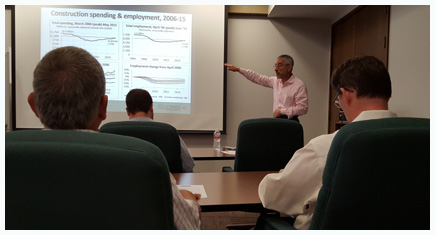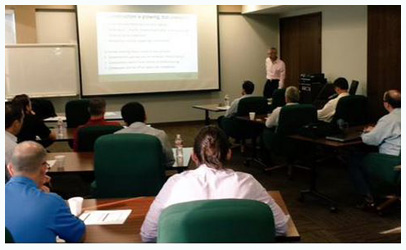 A survey conducted by the Associated General Contractors of America will show that the biggest challenge faced by contractors is their ability to attract new craft professionals.
A survey conducted by the Associated General Contractors of America will show that the biggest challenge faced by contractors is their ability to attract new craft professionals.
That news comes to us from AGC Chief Economist Ken Simonson as he tours the nation speaking to construction executives about the state of the economy. I caught up with Simonson, who is also a Construction Citizen author, when he was talking to contractors in Austin on Tuesday.
In the survey of about 1,300 contractors, 83 percent said it is difficult to find craft professionals while 61 percent said it is hard to fill management positions like project managers and estimators.
Sixty-six percent of contractors said it was hard to find carpenters, 64 percent said roofers are difficult to hire, 59 percent said they cannot find enough equipment operators, 54 percent said plumbers are especially hard to find, and 52 percent said electrician positions are very difficult to fill.
The full survey will be released soon, but Simonson was kind enough to share those numbers with us now.
“The attitude of contractors is quite positive,” Simonson said. “For the most part there is more work than there was a year ago,” he said, adding that things have really slowed down on the public works side as Congress has failed to approve new funding for highways, and many state legislatures tighten their budgets. “Government is shrinking in that regard.”
Work has been picking up on the private side as more corporate headquarters are being built, and projects like data centers are underway across the country.
Even the falling price of oil has not slowed the construction of petrochemical projects. Remember: the price of oil is down because supply is up and that increased supply still has to be refined even if the end product will be cheaper for the consumer. That’s why orders for new refineries are still on the books.
“The big worry for contractors is labor availability,” Simonson said. At least half the executives who responded to the AGC survey said they are experiencing difficulty finding the people they need for the projects they’ve either got on contract or will have on contract soon. “That’s been growing now for at least two years,” he said. “It's clear that this is a very widespread problem and a growing problem.”
At least half the executives who responded to the AGC survey said they are experiencing difficulty finding the people they need for the projects they’ve either got on contract or will have on contract soon. “That’s been growing now for at least two years,” he said. “It's clear that this is a very widespread problem and a growing problem.”
In some ways, Simonson said, the challenges faced by the industry are similar to problems it experienced a decade ago.
“The construction industry suffered the longest and deepest downturn in employment of any industry,” Simonson said, noting that 2.3 million people who had been working in construction were idled from 2006 to 2011. Over that 5-year period, other sectors either added jobs or brought workers back into the fold more quickly than construction.
This is why more companies are investing in training than they have in the past, Simonson said. Increased cooperation and collaboration with school districts, community colleges, and other organizations that have training programs for craft professionals has become essential. That’s the kind of work that has to be done to ensure career opportunities and a sustainable workforce.
“It's become even harder to convince young people that construction is a career that is viable and stable,” Simonson said. “We do have a bigger challenge.” But, Simonson is upbeat about the industry’s prospects moving forward. “Gradually, people will get the message that this isn't just backbreaking work and that you get to work with some cool tools,” Simonson said.
If you’re interested in finding out what it takes to start a career as a craft professional, learn more in the Craft Careers section of Construction Citizen.
Survey Shows the Biggest Concern of Contractors is Availability of Craft Professionals
by Scott Braddock | July 23, 2015


